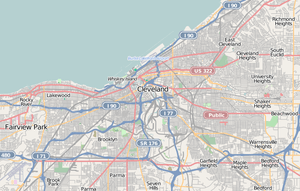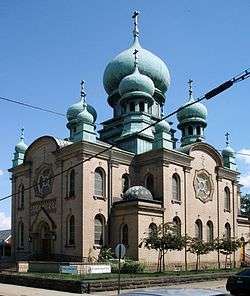Tremont, Cleveland
| Tremont | |
|---|---|
| Neighborhoods of Cleveland | |
|
The historic St. Theodosius Russian Orthodox Cathedral on Starkweather Ave. | |
| Coordinates: 41°28′25″N 81°41′19″W / 41.4736111°N 81.6886111°WCoordinates: 41°28′25″N 81°41′19″W / 41.4736111°N 81.6886111°W | |
| Country | United States |
| State | Ohio |
| County | Cuyahoga County |
| City | Cleveland |
| Population (2010) | |
| • Total | 6,912 |
| 15.3% decrease from 2000 Census | |
| Demographics | |
| • White | 53.8% |
| • Black | 21.5% |
| • Hispanic | 21.0% |
| • Asian | 0.8% |
| • Mixed and Other | 2.3% |
| Time zone | EST (UTC-5) |
| • Summer (DST) | EDT (UTC-4) |
| ZIP Codes | 44109, 44113 |
| Area code(s) | 216 |
| Median income | $21,711 |
| Source: 2010 U.S. Census, City Planning Commission of Cleveland[1] | |
|
Tremont Historic District | |
|
Lemko Hall, at the intersection of W.11th Street and Literary Road | |
   | |
| Location | Roughly bounded by I-490, I-71, University Ct., W. 7th St., Starkweather Ave., Brayton, Fruit Ave. and Auburn Ave., Cleveland, Ohio |
|---|---|
| Area | 184.7 acres (74.7 ha) |
| Built | 1851 |
| Architect | Multiple |
| Architectural style | Other, Late Victorian, Cleveland Double, American Foursquare, Carpenter Gothic, Stick style |
| NRHP Reference # | 94000719[2] |
| Added to NRHP | July 15, 1994 |
Tremont is a neighborhood in the city of Cleveland, Ohio, listed on the National Register of Historic Places. Tremont is one of the oldest parts of Cleveland, and once held a large German immigrant population.[3] Today the neighborhood is home to many restaurants and art galleries. The district sits just west of the Cuyahoga River and south of the Ohio City neighborhood. Tremont is home to numerous historic churches including Pilgrim Congregational UCC (founded in 1859),[4] St. Augustine (1893), St. John Cantius (1898), and St. Theodosius Russian Orthodox Cathedral (1912).Tremont is bounded by the Cuyahoga River to the North and East, MetroHealth Medical Center to the South and West 25th Street and Columbus Avenue to the West.[5]
History
Tremont, was originally part of Brooklyn Township and from 1836 until 1854 was a section of what is now its sister neighborhood, Ohio City, when the latter was an independent town. Both were later annexed by the city of Cleveland, but Tremont remained 1867.[6] During the early 1850s, the now defunct Cleveland University briefly occupied a section of Tremont, and in fact before being named Tremont the neighborhood was briefly known as University Heights (not to be confused with the eastern Cleveland suburb of the same name).[7] Vestiges of the neighborhood's days as a college town remain, however, in streets with scholarly names, such as Professor, Literary, College and University.[8] The early 20th century saw an influx of Ukrainian immigrants who sought work in the steel mills in the area,[9] and by the 1920s Tremont was home to over 35,000 residents.[7] By the 1960s, however, the population had begun to steadily decline. With the loss of manufacturing jobs particularly in Cleveland's steel industry, culminating in the recession of the early 1980s, Tremont's population dwindled. By the 2000 census there were fewer than 9,000 residents.[1]
Since the early 2000s, Tremont has reinvented itself and is experiencing a revival. With its close proximity to downtown and affordable dwellings, the neighborhood began a revival in the 1990s due in large part to an influx of new residents, including young professionals, empty nesters, hipsters and immigrants attracted to the neighborhood's amenities, historic housing stock and new infill housing.[10] Tremont has become a destination spot with numerous restaurants, shops, and art galleries. The Tremont Art Walk occurs on the 2nd Friday of each month.[11]
Neighborhood landmarks and points of interest
- Lemko Hall (2337 W. 11th St.) - The historic hall served as a social gathering place for the one-time sizable concentration of immigrants from the Slavic region of Lemkovina who lived in Tremont. Today it is a mixed use (retail and condominiums) structure and a city landmark. It is arguably most famous for being the site of the wedding reception in the 1978 film, The Deer Hunter.
- St. Theodosius Russian Orthodox Cathedral ( 733 Starkweather Ave.) - Also featured in The Deer Hunter, the cathedral was built in 1912, and is listed on the National Register of Historic Places.
- Pilgrim Congregational Church (2592 West 14th Street) - built in 1894, on the National Register of Historic Places.
- Lolita (900 Literary Road) - Iron Chef Winner, Michael Symon's bistro is one of a number of standout neighborhood eateries.

- A Christmas Story House (3159 West 11th Street) - Site of several exterior scenes in the 1983 holiday film, A Christmas Story, the house was home to protagonist Ralphie Parker and his family. It was purchased on eBay in 2004 by San Diego entrepreneur Brian Jones and subsequently renovated to replicate the interior and exterior as seen in the film, and is now a museum.[12]
- T.R.E.A.T.S (Tremont Residents Empowering Animals To Socialize) Dog Park Located at Clark Field - the largest off-leash canine play park in the Cleveland area.[13]
- The Chelsea Building is one of the oldest high rise buildings constructed in Cleveland, being erected in 1898. The building also has the first residential elevator installed in the city.
- 2207 Seymour Avenue - Ariel Castro's House of Horrors, where he tortured three girls from 2004 to 2013. This house no longer exists (because if it did, it would probably be cursed).
References
- 1 2 "Census 2010 PL94-171 Redistricting Data for Cleveland's Statistical Planning Areas (Yr 2000 boundaries)" (PDF). Cleveland City Planning Commission. City of Cleveland. Retrieved April 3, 2013.
- ↑ National Park Service (2010-07-09). "National Register Information System". National Register of Historic Places. National Park Service.
- ↑ http://cleveland.about.com/od/livingincleveland/tp/ethnicheritage.htm
- ↑ "Pilgrim Church". Retrieved 2009-09-08.
- ↑ "Tremont West Development Corporation: Location". Retrieved 2013-05-07.
- ↑ Encyclopedia of Cleveland History:TREMONT
- 1 2 Neighborhood Tour
- ↑ Encyclopedia of Cleveland History:
- ↑ http://ech.case.edu/cgi/article.pl?id=U[]
- ↑ Wren, Patricia (2008-11-30). "Tremont is an artsy, lively neighborhood with great rental opportunities". The Plain Dealer,. Cleveland, Ohio. Retrieved 2011-07-12.
- ↑ Tremont ArtWalk Cleveland Ohio Art
- ↑ "Handle With Care". Cleveland Magazine. Great Lakes Publishing. 36: 128–196. November 2006.
- ↑ T.R.E.A.T.S. - Welcome To Tremont!
External links
| Wikimedia Commons has media related to Tremont, Cleveland. |
 |
Ohio City | Downtown Cleveland |  | |
| Clark-Fulton | |
Industrial Valley | ||
| ||||
| | ||||
| Brooklyn Centre | Cuyahoga Heights, Ohio | Slavic Village |



